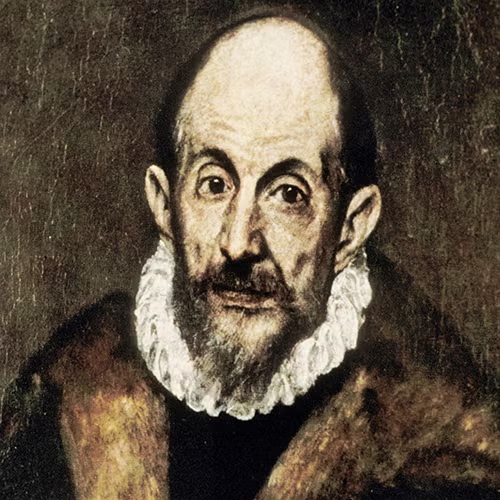
Table of Contents
Who Was El Greco?
El Greco, born around 1541 on the island of Crete, was a prominent painter whose influence bridged the Renaissance and the early modern period. Originally named Domenikos Theotokopoulos, he trained in Venice under the great master Titian, before relocating to Toledo, Spain, where he created his most famous works. Known for his distinct, elongated figures and dramatic use of color, El Greco’s art was ahead of its time, often seen as a precursor to both Expressionism and Cubism. Though his contemporaries found his style perplexing, his contributions are now celebrated as integral to the evolution of Western art.
Early Years: Venice and Rome
In his early 20s, El Greco left Crete, then part of the Republic of Venice, to study in Venice itself. Under the mentorship of Titian, he refined his skills in perspective, figure construction, and complex narrative scenes—traits visible in works like The Miracle of Christ Healing the Blind. Around 1570, El Greco moved to Rome, where he lived in the palace of Cardinal Alessandro Farnese, a key patron of the arts. Despite joining the Roman painters’ academy in 1572 and establishing a studio, El Greco struggled to find success. His open criticism of Michelangelo likely alienated him from the Roman art community, prompting his departure for Spain in 1576, where his career flourished.
Finding Success in Toledo: El Greco’s Artistic Foothold
After failing to secure royal patronage in Madrid under King Philip II, El Greco relocated to Toledo, where his career began to flourish. In Toledo, he formed a pivotal relationship with Diego de Castilla, the dean of the Toledo Cathedral. Castilla commissioned El Greco to create a series of works for the altar of the church of Santo Domingo el Antiguo, including The Trinity and The Assumption of the Virgin (both 1579). This opportunity marked a turning point in his career, leading to the creation of one of his most renowned works, The Disrobing of Christ (1579). However, a financial dispute over this piece would limit future commissions from Castilla.
Despite this setback, El Greco’s career in Toledo thrived. He produced some of his most significant masterpieces, such as St. Sebastian (1578), St. Peter in Tears (1582), and The Burial of Count Orgaz (1588). The latter became one of his defining works, blending the earthly and divine with a visionary intensity. It represents El Greco’s mastery in capturing both the physical and spiritual realms, embodying the ethereal quality that would distinguish his artistic style.
El Greco’s exploration of new themes culminated in View of Toledo (1597), widely regarded as the first landscape in Spanish art. Rare for its genre, this painting stands out as one of the few landscapes created by the artist, who predominantly focused on religious subjects and portraits.
Later Years and Lasting Legacy
In his later years, El Greco’s work became increasingly bold, characterized by elongated and distorted figures that challenged conventional depictions of the human form. This unique style can be seen in works like The Adoration of the Shepherds (1599), Concert of Angels (1610), and The Opening of the Fifth Seal (1614). The Fifth Seal, in particular, has been linked to Pablo Picasso’s Les Demoiselles d’Avignon, suggesting El Greco’s influence on modern art, particularly cubism.
El Greco’s impact extended far beyond Picasso, influencing numerous art movements, from cubism and expressionism to abstract impressionism. His unconventional use of color and form captivated future generations of artists. His influence also reached literary figures like Rainer Maria Rilke and Nikos Kazantzakis. Although El Greco died on April 7, 1614, largely unrecognized in his time, his genius was eventually acknowledged, and he is now celebrated as one of the great masters of art.
